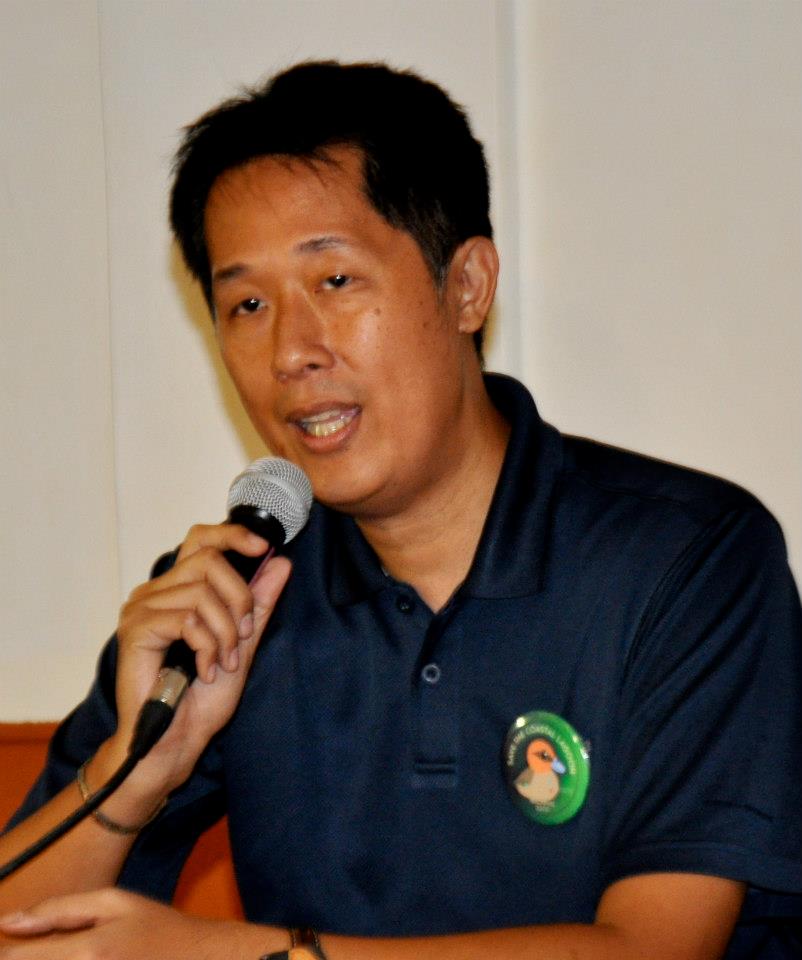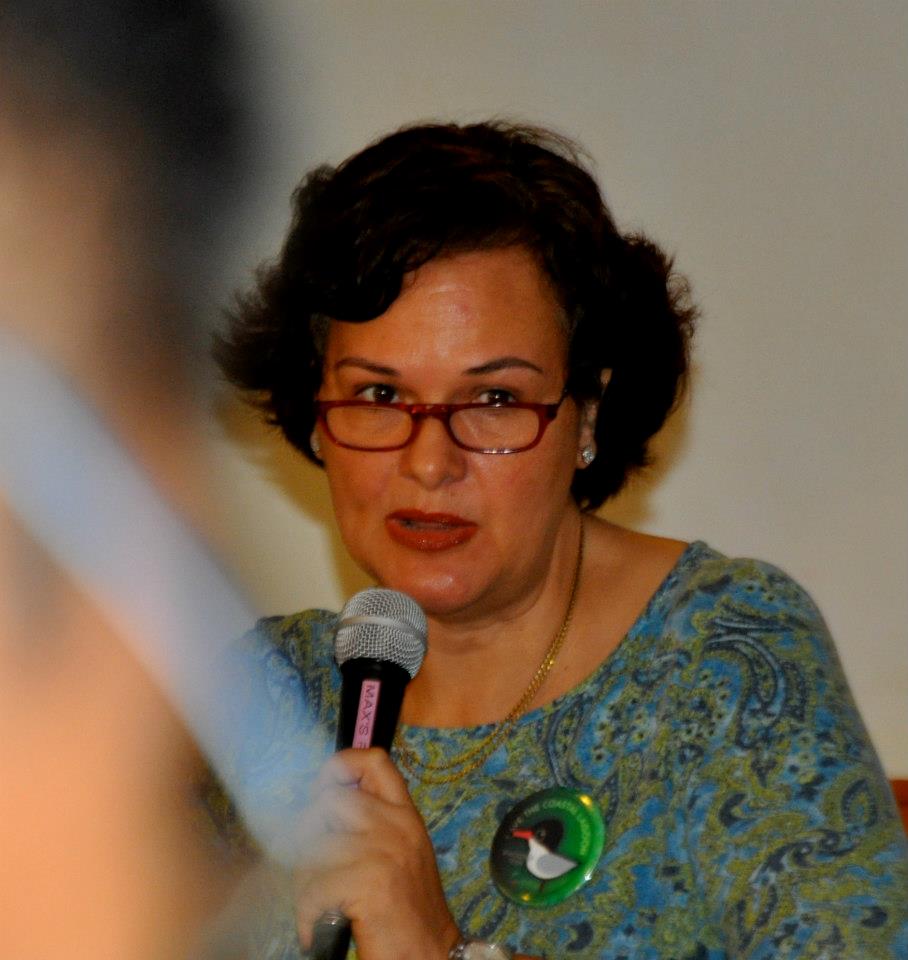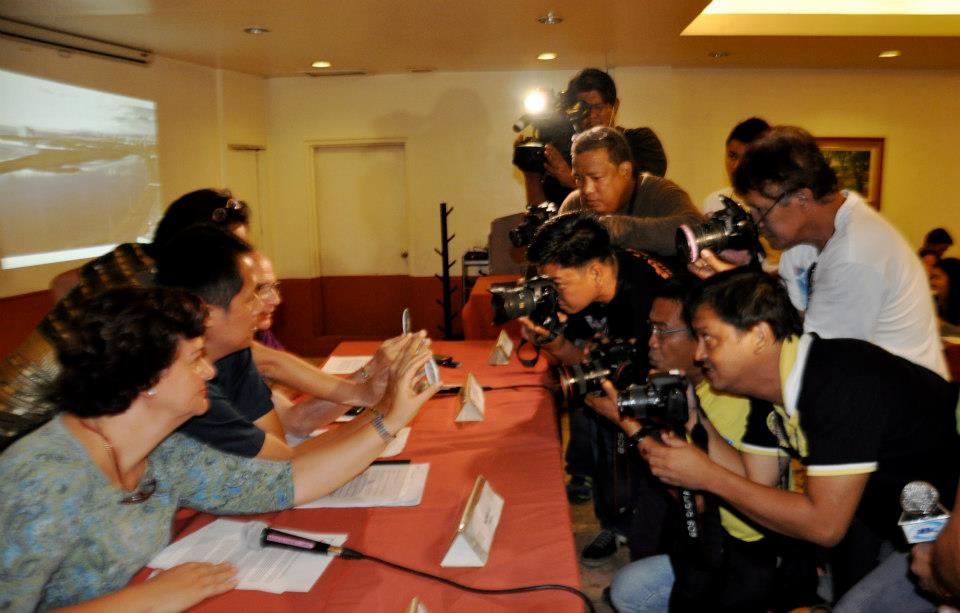WBCP was in the news to set the public straight about the relationship between bird strikes, airports, and bird sanctuaries.
space
WBCP PRESS CONFERENCE
by Anthony Arbias

The Wild Bird Club of the Philippines (WBCP) led by President Mike Lu, Vice President Gina Mapua, Ornithologist Arne Jensen and Atty. Ipat Luna held a press conference last September 12, 2012 about the recent issues on bird strikes and the controversial reclamation plans which would particularly affect the ecological balance and the avian population in the Las Pinas Paranaque Critical Habitat and Ecotourism Areas or LPPCHEA.
Club VP Gina read the official statement “Bird strikes? Or Strike Three for the Reclamation Plans?” over more than three dozen media men both from TV and print who covered the lunchtime presscon at Max’s Orosa street in Malate Manila. The issue rooted from a news report of a bird strike on a plane landing in Tacloban which later on shuffled on a plan to reclaim 600 hectares of sea behind the lagoon and the recommended closure of LPPCHEA because of a possibilities of bird strikes at the Ninoy Aquino International Airport (NAIA).
The reported plan would imperil the avian life along the lagoon which is home to an estimated 5,000 birds during peak periods of the migratory season. The club’s three year database also reveals that the lagoon also hosts more than 80 species of birds which is the highest in any site in Metro Manila.
Internationally known Ornithologist and bird strike adviser to Scandanavia’s largest airport, Arne Jensen says “You don’t solve potential bird strikes in NAIA by trying to vacuum-clean Coastal Lagoon. There are more than 100,000 wetlands birds in Manila Bay moving from and back every day and every season and they can’t be eliminated”. He added that “if NAIA does not know what species are causing problems, any extirpation attempt becomes absurd and a waste of money.”
The presscon immediately hit primetime news the same day and on print the following day. News items were also shared on the net and the social media by fellow birders and concerned citizens since it came to light two weeks ago.
As the days go by and earthly plans continue to unravel, the salvation of the lagoon should not just depend on bird loving citizens but to a whole citizenry hungry of ecological healing.
——–
Here is the full text of the WBCP Press Statement.
Bird strikes? Or Strike Three for the Reclamation Plans?
A recent bird strike on a plane landing in Tacloban has been made to appear as
if it is in Metro Manila to raise enough of a ruckus and fear-mongering so a
property developer could remove a thorn on its back – a critical habitat in
Metro Manila reminiscent of the area’s original mangrove-lined coasts.
The project is an agreement that the cities of Parañaque and Las Piñas entered
into with All Tech Contractors, Inc. to reclaim 600+ hectares of the sea behind
the Coastal Lagoon. Since Amari’s contract with then PEA for this reclamation
was declared unconstitutional in 2002, it is being resurrected with a new
company, and DENR issued a new ECC despite protests from the Wild Bird Club of
the Philippines. The statement on bird strikes was issued by Ramon Ang, now a
major stockholder of Philippine Airlines.
In 2007 the Club’s 3-year database of bird records proved that the Coastal
Lagoon hosts up to 5,000 birds during peak periods of the migratory bird
season. More than 80 species of birds have been recorded (the highest number of
species in any site in Metro Manila) including records of more than 2% of the
East Asian-Australasian Flyway population of Black-winged Stilts; a nominator
for protection under the international wetland protection convention, the Ramsar
Convention. This, and a recorded 67 species of mollusks that serve as their
food is indicative of a thriving ecosystem.
Thus, in April 2007, Presidential Proclamation 1412 and the subsequent amendment
1412-A ordered that all relevant departments should “Ensure that any reclamation
in the periphery of the Las Piñas-Parañaque Critical Habitat and Ecotourism Area
shall not impede the ecological function of the lagoon and its small islands’
mangroves, salt marshes and tidal areas as breeding, feeding and roosting place
for marine and terrestrial wildlife”. It further ordered that such departments
“Maintain a minimum 15% of the 1,500 total area of the Bay City (Boulevard 2000
Project) consisting of existing wildlife habitats and protect their
characteristics as such.”
These provisions are making it difficult for the Philippine Reclamation
Authority to go ahead with its proposed massive reclamation just behind the
Critical Habitat. It takes elementary ecology to understand that the habitat is
the way it is because of its proximity to the sea. It is also quite ludicrous
to say that closing the sanctuary will remove the birds. If a sanctuary within
their migratory path suddenly disappears, they will scatter even more to areas
nearer the airport where they may pose a danger. In fact, closing the bird
sanctuary will pose a greater danger to people than keeping it.
The Wild Bird Club of the Philippines holds the safety of passengers in
airplanes paramount, but there is not a shred of evidence that the Critical
Habitat is in any way connected with any bird strikes in Metro Manila. Neither
airlines nor airport authorities have given us any information as to species,
whether they happened during take off or landing, or what time of year or
whether they are migratory or resident birds. A document from the Federal
Aviation Administration IN USA states that “The majority of wildlife strikes
occur within the immediate airport environment: 74% of all strikes occur at or
below 500 feet above ground level”. But in fact several airports around the
world co-exist well with sanctuaries and large bird populations close to them,
including London Heathrow and Bangkok’s new Suvarnabhumi Airport, some of the
busiest in the world.
The Club’s Records Committee Chair, Ornithologist Arne Jensen, who for 11 years
worked professionally as Bird Strike Advisor for the authorities of Copenhagen
Airport, the largest in Scandinavia and located next to two major bird
sanctuaries, says of the plan to remove the sanctuary: “You don’t solve
potential bird strikes in NAIA by trying to vacuum-clean Coastal Lagoon. There
are more than 100,000 wetlands birds in Manila Bay moving from and back every
day and every season and they can’t be eliminated. Further, each bird
species/family requires different bird strike adaptation and mitigation
strategies which NAIA has not fully developed yet. And if you don’t know the
location and altitude of strikes and what species are causing problems, any
extirpation attempt becomes absurd and a waste of money.”
We think instead of blaming birds, a more interesting story is figuring out the
connections between Ang, Amari and All Tech and how this 20-year old story about
the grandmother of all scams just refuses to die.
——–
WBCP President Mike Lu and Cong. Cynthia Villar interviewed by Kara David on GMA News on September 24, 2012
[youtube=http://www.youtube.com/watch?v=PnQZ-azjie4]






